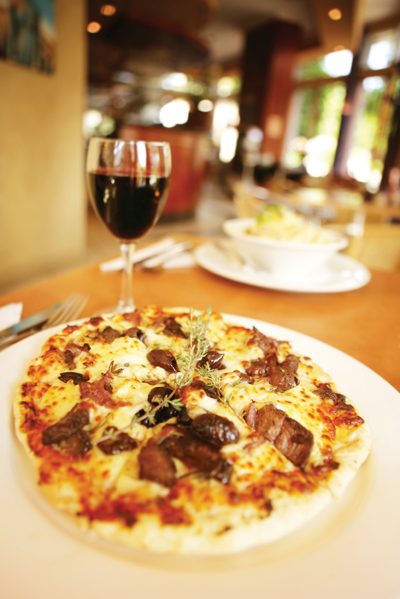
Maketing Insights: Perfect pairings
Michelle Brisebois
Features Business and Operations MarketingPerfect pairings
Think of your menu as an edible strategic plan. This means everything on it must fill a market niche for the consumer and address a business objective for you. The wine list can enhance your customer’s dining experience, increase your cheque average and make your restaurant a destination point. Unfortunately, most restaurant wine lists are a bit of a motley crew. Often they offer a collection of merlot and chardonnay warhorses without integrating vintages into the menu at all. While your winery sales representative is the best resource to help you match wines with your menu items, there are a few rules that may help you decide whether your old standbys still belong in the mix.

|
|
| While pizza and beer is a traditional match, well-paired wine can really make your dishes shine.
|
Think of your menu as an edible strategic plan. This means everything on it must fill a market niche for the consumer and address a business objective for you. The wine list can enhance your customer’s dining experience, increase your cheque average and make your restaurant a destination point. Unfortunately, most restaurant wine lists are a bit of a motley crew. Often they offer a collection of merlot and chardonnay warhorses without integrating vintages into the menu at all. While your winery sales representative is the best resource to help you match wines with your menu items, there are a few rules that may help you decide whether your old standbys still belong in the mix.
Match the wine to the strongest flavour in the dish
If the menu item is a Mediterranean pizza with grilled vegetables, then perhaps the sun-dried tomatoes will be the dominant flavour. In this case, a light red wine such as a rosé or gamay noir would work well. If the pizza has spicy pepperoni as one of the ingredients, then a bold red with peppery notes such as a shiraz or cabernet sauvignon might be a fit.
Play the weighting game
Make sure that the weight of the wine is balanced to the weight of the food. A full-flavoured meal needs a full-bodied wine; a lighter dish calls for a lighter wine. A hearty beef stew or spicy chili would dwarf a light white, while a delicate fish would get lost beside a bold red. It is possible to have red wines pair with foods traditionally matched with white wines, such as chicken or fish. It’s simply a matter of ensuring there’s a bridge flavour in the dish to connect it to the wine. A fish in a tomato sauce or chicken with spicy barbeque sauce would make both of these foods red wine friendly.
White wine with steak? You bet!
Dishes that are rich or fatty work best with a dry wine with acidity to clean the palate. This is why oaky, dry chardonnays work well with a turkey dinner and gravy. Oaked chardonnays are fuller bodied and their creaminess complements rich sauces like Alfredo. For customers who would love to try white wine with steak, suggest mushrooms sautéed in butter as a topping and pair it with a buttery chardonnay.
Salty and sweet
Salt is a flavour enhancer. Pairing it with sweeter wines will bring out the lovely fruit flavours of the drink. Gewürztraminer, muscat and riesling wines all work beautifully with Asian inspired dishes. Make sure the wine boasts full fruit flavours, moderate acidity, lower alcohol and no tannins to strike the right balance.
Just desserts
Canadian wines are booming in popularity. Wine regions in a number of provinces are gaining international recognition with their award-winning vintages. Localvores – those consumers who prefer their foods grown close to home – are rising in numbers as well. Canada is known for its icewines and these delicacies can make your dessert menus sing. Make sure the dessert wine is sweeter than the dessert and keep in mind that a beautiful cabernet franc icewine is the most amazing complement to a chocolate dessert.
Rare, medium or well done
Rare meats need young tannic reds because the tannins cut through the protein in these cuts that coat the tongue. A nice, dry merlot works well with rare meats. If your customers request their meats well-done, older or fruity reds with few to no tannins will offer a better balance.
What to do about those tangy tomato sauces
Foods high in acidity are complemented by wines high in acidity, so while one merlot may be very smooth and mellow, another merlot may offer more acidity. If your menu includes many dishes featuring tomato sauces then it would be a very good idea to choose a slightly acidic red wine as your house wine. Make sure your house wine is special as well as being affordable. It must deliver on taste and versatility as it will be one of your signature items.
Think pink
One of the fastest growing wine segments is rosé wine. The sweet incarnations of the 1970s gave rosé a bad reputation, but the French wine industry has spent a lot of energy promoting pink wine with good reason. Rosé wines are very food friendly and offer the perfect complement to Mediterranean dishes. It’s a great way for a couple to share a bottle of wine if one likes red and the other prefers white.
Michelle Brisebois is a marketing professional with experience in the food, pharmaceutical, financial services and wine industries. She specializes in retail brand strategies.
Print this page